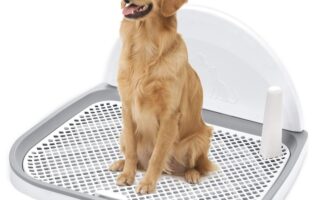Puppy Digging in Crate: Understanding the Whys and How to Cope
Bringing a puppy into your home is like opening a vibrant, wagging chapter of joy and discovery. However, as adorable as these little bundles of fur can be, they often come with their own set of curious behaviors that might leave owners scratching their heads—quite literally. One such behavior is digging, often observed when puppies are placed in their crates. This instinctual action, while seemingly harmless, can raise concerns and questions for pet owners. Why does a puppy dig in its crate? Is it a sign of anxiety, boredom, or simply playfulness? This article delves into the motivations behind this behavior, offering insights and practical tips to help owners understand and address their puppy’s digging tendencies. Whether you are a new puppy parent or a seasoned dog lover, having a toolbox of knowledge at your disposal can transform crate time from a puzzling experience into a harmonious routine. Let’s embark on this journey to uncover the reasons behind the digging and how to cultivate a calming crate environment for your furry friend.
Table of Contents
- Understanding the Root Causes of Crate Digging Behavior
- Effective Strategies to Deter Unwanted Crate Digging
- Creating a Comfortable Crate Environment for Your Puppy
- When to Seek Professional Help for Crate Digging Issues
- Q&A
- Insights and Conclusions
Understanding the Root Causes of Crate Digging Behavior
Crate digging in puppies can often be a puzzling behavior for pet owners. To understand this tendency, it’s important to look at several possible root causes that influence a puppy’s actions within their crate. Some contributing factors include:
- Instinctual Behavior: Puppies have an innate drive to dig, which can stem from their ancestral roots. This behavior likely harks back to their wild ancestors who dug to create a comfortable den or to hide food and protect their young.
- Stress and Anxiety: A puppy may resort to digging as a coping mechanism in response to stress or anxiety. Crate training should always focus on making the crate a safe and welcoming space.
- Excess Energy: Young dogs, full of energy, may dig in a crate as a form of play or to alleviate boredom, indicating a need for more physical exercise and mental stimulation.
To effectively address the discomfort that leads to digging, consider the following tailored approaches:
| Approach | Description |
|---|---|
| Proper Exercise | Ensuring adequate physical activity to tire your puppy can minimize digging behavior. |
| Comfortable Environment | Adding soft bedding or safe toys can make the crate a more inviting space. |
| Positive Reinforcement | Rewarding your puppy for calm behavior in the crate reinforces relaxation. |
Effective Strategies to Deter Unwanted Crate Digging
To effectively discourage your puppy from digging in their crate, it’s essential to create a comfortable and engaging environment. Comfort is key; ensure that the crate is cozy with soft bedding and a few safe toys to keep your puppy entertained. Moreover, using interactive toys can help redirect their digging instincts into something more constructive. Rotating the toys regularly can maintain your puppy’s interest and keep boredom at bay, significantly reducing the desire to dig.
Establishing a consistent routine can also contribute to a calmer crate experience. Regular exercise and playtime outside the crate can help release pent-up energy, making your puppy more likely to relax when crated. You can implement training techniques such as short separation periods, gradually increasing the time spent in the crate to help them adapt. Rewarding your puppy for calm behavior in the crate with treats or praise will reinforce positive habits and teach them that the crate is a safe, happy place.
Creating a Comfortable Crate Environment for Your Puppy
Creating a cozy and inviting space in your puppy’s crate can greatly reduce their inclination to dig and scratch at the bedding. Start by selecting a crate that is just the right size—one that allows your puppy to stand, turn around, and lie down comfortably. You can enhance the environment with the following elements:
- Soft Bedding: Use thick, plush blankets or a comfy dog bed to provide warmth and comfort.
- Toys: Include a few safe chew toys to keep them occupied and encourage positive behavior.
- Aromatherapy: Consider the use of calming scents such as lavender to help soothe your puppy’s anxiety.
- Consistent Location: Place the crate in a quiet, familiar spot where your puppy feels secure, away from loud noises.
Additionally, using a cover or crate blanket can give your puppy a sense of security by creating a more den-like atmosphere. However, ensure ventilation remains adequate. When your puppy spends time in their crate, take the opportunity to positively reinforce their good behavior with treats or praise when they settle down quietly. This encourages them to see their crate as a safe haven rather than a confinement:
| Tips for a Comfortable Crate | Benefits |
|---|---|
| Choose the Right Size | Prevents stress, encourages relaxation |
| Use Cozy Bedding | Enhances comfort, discourages digging |
| Incorporate Chew Toys | Keeps them engaged, reduces boredom |
| Maintain a Calm Environment | Minimizes anxiety, promotes peacefulness |
When to Seek Professional Help for Crate Digging Issues
Determining the right moment to consult a professional can be challenging for pet owners experiencing crate digging issues with their puppies. If the behavior persists despite your best efforts, it’s prudent to consider seeking help. Signs indicating that it’s time for an intervention include:
- Excessive Digging: When your puppy spends an extended period digging, causing distress or injury.
- Destruction: Increasing damage to the crate or surrounding area can signal deeper anxiety.
- Signs of Stress: Repeated barking, whining, or panting could indicate that crating is not working for your dog.
- Changes in Behavior: Sudden shifts in behavior towards the crate can reveal emotional or psychological issues.
Consulting with a veterinarian or a certified dog trainer can provide valuable insights tailored to your puppy’s specific needs. They can help uncover underlying problems such as:
| Underlying Problems | Potential Solutions |
|---|---|
| Separation Anxiety | Gradual desensitization to crate time. |
| Health Issues | Veterinary examination to rule out pain or discomfort. |
| Lack of Exercise | Increase daily physical and mental stimulation. |
Q&A
Q&A: Understanding Your Puppy’s Crate Digging Behavior
Q1: Why is my puppy digging in their crate?
A1: Puppies may dig in their crates for a number of reasons. Instinctively, digging is a natural behavior for many breeds, often linked to their ancestry as den diggers. Additionally, your puppy may be trying to create a more comfortable resting spot or may simply be bored or anxious. It’s their way of expressing restlessness or exploring their environment.
Q2: Is digging a sign of distress or anxiety in my puppy?
A2: It can be. While some puppies dig out of instinct, others may be responding to feelings of stress or separation anxiety. If your puppy digs excessively, it’s essential to consider whether they are comfortable in their crate. Signs of anxiety may include whining, barking, and pacing around the crate. If you suspect anxiety, establishing a soothing routine or consulting a veterinarian can help.
Q3: How can I discourage my puppy from digging in the crate?
A3: To discourage digging, first ensure the crate is a positive and comfortable space. Incorporate soft bedding and safe toys. Additionally, increase your puppy’s physical activity and mental stimulation through regular playtime and training sessions. If the digging persists, you might consider a larger crate or modifying their environment to reduce boredom.
Q4: Could the crate itself be a contributing factor to the digging?
A4: Absolutely! If the crate is too small, uncomfortable, or lacks stimulating distractions, your puppy might dig out of frustration or discomfort. Ensure that the crate provides enough space for your puppy to stand up, turn around, and lie down comfortably.
Q5: When should I be concerned about my puppy’s digging behavior?
A5: If digging escalates to the point where your puppy injures themselves or creates a significant mess, it may be time for a deeper intervention. Persistent digging in combination with other signs of distress can signal an underlying issue that might require professional guidance from a dog trainer or veterinarian.
Q6: Are there any products that can help with the digging behavior?
A6: Yes! There are a variety of products available that can help redirect your puppy’s digging instincts. Look for sturdy chew toys, puzzle toys that dispense treats, and protective pads that can make the crate less appealing for digging. Additionally, crating your puppy for short, positive durations can help them associate it with comfort rather than restlessness.
Q7: How long does it typically take for a puppy to adjust to a crate?
A7: Every puppy is different, but many can adjust to crate training within a few days to a couple of weeks. Gradually introducing the crate with positive reinforcement can create a more enjoyable and relaxing experience. Patience and consistency are key, as each puppy’s adjustment period may vary based on their background and temperament.
Q8: Should I consider alternatives to crating if my puppy continues to dig?
A8: If digging persists despite your efforts, you may want to explore alternative options such as puppy playpens or gated areas in your home where your puppy can feel secure while still having space to move. These alternatives can provide a safe environment without the confines of a crate, allowing your puppy to thrive.
Understanding the motivations behind your puppy’s digging behavior in their crate can lead to a happier and more comfortable experience for both you and your furry friend. With patience and the right strategies, you can help your puppy develop positive crate habits!
Insights and Conclusions
As we conclude our exploration of the curious phenomenon of puppy digging in crates, it’s essential to remember that this behavior is often a natural expression of a young dog’s energy and instincts. While digging may seem perplexing or even frustrating at times, it can also be an opportunity for bonding and understanding between you and your furry companion. By recognizing the underlying motivations for this behavior and implementing appropriate strategies, you can create a positive and enriching environment for your pup. Embrace the playful spirit of your little digger, and with a bit of patience and guidance, you’ll both discover the joys of crate training and the adventures that lie ahead. After all, every paw print in the crate tells a story — one of growth, learning, and the unbreakable bond between you and your beloved puppy. Happy training!



